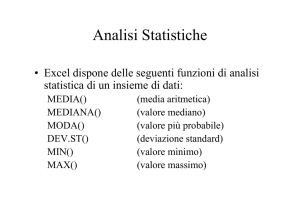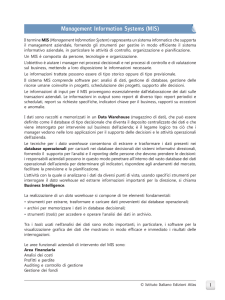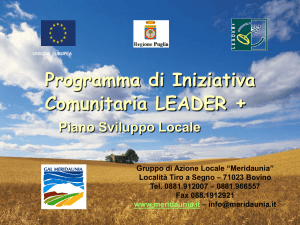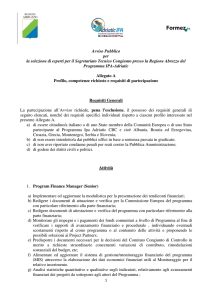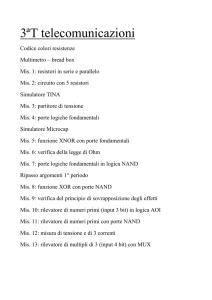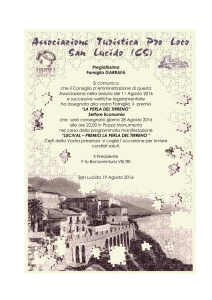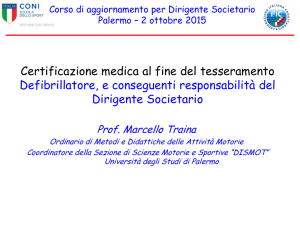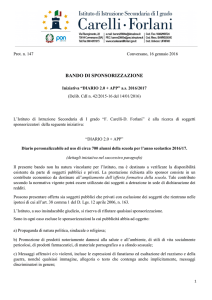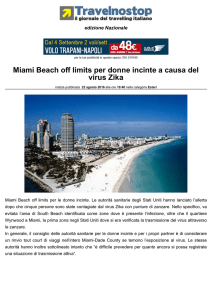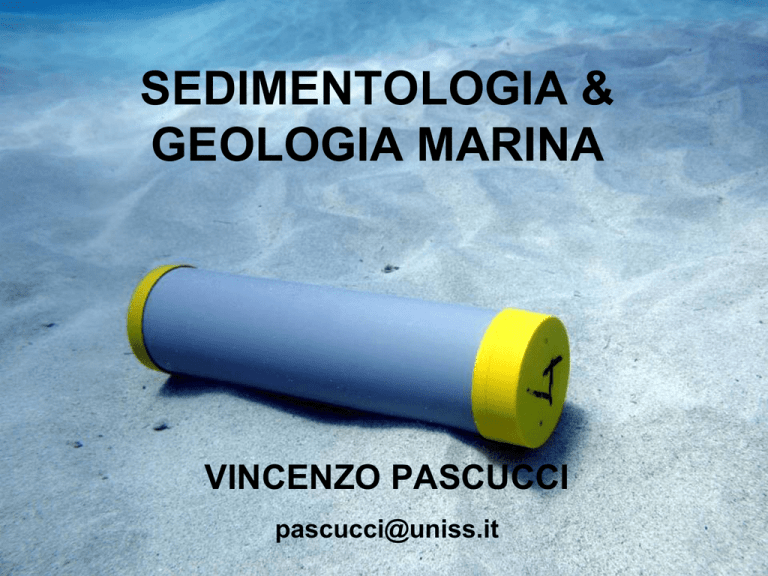
SEDIMENTOLOGIA &
GEOLOGIA MARINA
VINCENZO PASCUCCI
[email protected]
TEAM
• 2 DOTTORANDI (II Anno Cb, I Anno Sb);
• 1 PO
COLLABORAZIONI NAZIONALI
•
UNIVERSITA’ DI CAGLIARI (DR. ANDREUCCI)
•
UNIVERSITA’ MILANO “LA BICOCCA” (PROF. MARTINI)
•
UNIVERSITA’ DI SIENA (PROF. SANDRELLI, DR.
CORNAMUSINI)
•
UNIVERSITA’ DI PISA (DR. ZANCHETTA)
•
CNR-PISA ISTITUTO DI GEOSCIENZE E GEORISORSE (IGG)
(DR. DALLAI)
•
CNR-NAPOLI GEOMARE (SEDE DI TORRE GRANDE-OR) (DR.
DE FALCO)
•
ENEA (ROMA) – (DR. CAPPUCCI)
COLLABORAZIONI INTERNAZIONALI
•
UNIVERSITY OF COPENHAGEN (DK) (PROF. CLEMMENSEN);
•
NORDISK LAB FOR OSL DATING (DK) (DR. MURRAY);
•
UNIVERSITY OF DALHOUSIE (CA) (PROF. GIBLING);
•
UNIVERSITY OF GUELPH (CA) (PROF. MARTINI);
•
UNIVERSITY OF PERPIGNAN (FR) (PROF. VILLARD)
•
UNIVERSITY OF SHEFFIELD (UK) (PROF. BATEMAN)
•
UNIVERSITY OF ÇUKUROVA (TR) (PROF. KAPUR)
LABORATORI
• DATAZIONI OSL (FINANZIAMENTO PROGETTO
CeSAR, GA);
• SEDIMENTOLOGIA (SABBIE & GHIAIE)
• GEOFISICA: GEORADAR (100-200-600 MHz), SONAR
(SINGLE BEAM & SIDE SCAN SONAR)
TEMATICHE DI RICERCA
• VARIAZIONI CLIMATICHE PASSATE E
RECENTI
• ANALISI DI BACINO
ANALISI DI BACINO
• EVOLUZIONE TETTONICA DEL
TIRRENO SETTENTRIONALE
• EVOLUZIONE DEL MARGINE SARDO
DEL TIRRENO MERIDIONALE
Evoluzione tettonica del Tirreno Settentrionale
con UNISI
Evoluzione del Margine Sardo del Tirreno meridionale
con Uni Perpignan
VARIAZIONI CLIMATICHE
• VARIAZIONI CLIMATICHE DEGLI ULTIMI 200 KY
(TARDO QUATERNARIO E OLOCENE)
• VARIAZIONI ATTUALI DELLE LINEE DI COSTA
• CARATTERIZZAZIONE CHIMICA ED ISOTOPICA DEL
PARTICOLATO ATMOSFERICO (PM, PM2.5) E DEI
TENORI DI CO2, VALORI DI FONDO E DI IMPATTO
ANTROPICO, IN AMBIENTE INSULARE
VARIAZIONI CLIMATICHE DEGLI ULTIMI 200 KY:
Gli affioramenti
La struttura interna (georadar)
La datazione degli eventi:
lLa luminescenza ottica (OSL)
La luminescenza è il feonomeno per il quale i minerali che vengono
stimolati da energia emettono fotoni
Thermoluminescence
(TL)
Optically Stimulated
Luminescence
(OSL)
PRINCIPLES OF OSL DATING
External dose (Dose rate)
Mineral grains in the sediment are exposed to ionizing
radiation from the decay of naturally occurring
radionuclides from within the sediment (external dose).
Energy absorption during burial
Ionising radiation
(α, β, γ) from the decay
of 238U, 232Th, 40K
After Aitken (1998)
COSA SI DATA?
IL TEMPO DI SEPPELLIMENTO
(OVVERO L’ULTIMO MOMENTO DI ESPOSIZIONE ALLA LUCE:
Sediment was last exposed to light
Ceramics (or stones) were last heated
Equivalent dose (De) Gy
Age (Ka) =
Dose rate (Gy/Ka)
Assumptions
1 Gy = 1 J / kg
1 ka = 1000 years
(i)
(i)
no trapped charge when the sediment was deposited or
ceramic was heated (i.e. fully reset, bleached or zeroed).
dose rate has been constant through time.
Principles of OSL dating
Sample collection
Time
Erosion, Tansport,
Deposition or Heating
Laboratory measurement
Luminescence
Bleaching
Level in mineral
grains before
erosion
(sediment) or
heating
(ceramic)
Latent luminescence
Signal buildup – Sample collection – Luminescence measurement
LUMINESCENCE
AGE
Measurement time
Natural signal
Natural signal: the number of photons counted are proportional to
the number of free charges.
RISULTATI
• INFO SUL CAMBIAMENTO DEL LIVELLO DEL MARE
RISPETTO A QUELLO ATTUALE;
• INFO SULLE VARIAZIONI DELLA TEMPERATURA
RISPETTO A QUELLE ATTUALI
CAMBIAMENTO DEL LIVELLO DEL MARE
•
125ky (MIS 5e) livello del mare era +4m più alto di quello di oggi;
•
100ky (MIS5c) livello del mare era +41.5 più alto di quello di oggi;
•
A partire da 80ky (end of MIS 5c) livello del mare comincia a scendere;
•
Raggiunge il massimo -120 slm circa 20-18ky (MIS 2);
•
Tra 17-11ky il livello del mare risale molto velocemente (end MIS2);
•
Da circa 10ky è al suo massimo con minime variazioni (MIS 1)
TEMPERATURA E CLIMA
•
125-95 ky (MIS 5e) temp era almeno +2/4 °C più alta di quella di oggi
(subtropical climate). Apice dell’ interglaciale;
•
90-80ky (MIS 5a) temp si raffredda (-3/4 °C minore di oggi, warm and humid).
Fine dell’interglaciale;
•
60-45ky (MIS 4) temp era -6/8 °C più bassa di quella di oggi (exposure of
shelf; cold and humiddry);
•
45-20ky (MIS 3-2) temp era -8/10 °C più bassa di quella di oggi (cold and very
dry). Apice del glaciale
RISULTATI MOLTO INTERESSANTI
FRA 59-24 ky MIS3
•
MIS 3. Durante questa fase fredda il livello del mare diminuì sufficentemente da esporre I
sedimenti marini che si erano accumulati sulla piattaforma. Tuttavia le frequenti oscillazioni
climatiche (eventi H o D/O) favorivano il depositarsi di dune eoliche costiere (periodi freddi)
o di depositi alluvionali (flash flood).
•
Sono stato riconosciuti 3 eventi Dansgaard-Oeschger: D/O13 (ca 47 ka), D/O8 (ca 39 ka)
and D/O2 (ca 24 ka).
RISULTATI INTERESSANTI
20 ky (MIS2)
CAPO CACCIA 20ky
VARIAZIONI ATTUALI DELLE LINEE DI COSTA
LA SPIAGGIA DELLA PELOSA
Highly biclastic sand;
Source: offshore from Posidonia meadow
Bf
Sf
Sw-field (old)
Po
FINE SAND
(220 μm)
MEDIUM SAND
(300 µm)
OLD SANDWAVE FIELD
NEW SW FIELD
Mega ripples
Sand waves
13.5m x 1.0-0.5m
Old SW field
CONCLUSIONS
•
Natural and human causes play together to erode La Pelosa beach. Most of
sand is taken away from the beach by natural events (change in wind regime)
although human impact due to tourists and the presence of a jersey is not
secondary;
•
No sediments are coming from inland because of the intense building of the
coast. The only possible sediment source is offshore from the Posidonia;
meadow that is, however, flooded by the sandwaves;
•
Wide and highly mobile sandwave fields are developing offshore of the La
Pelosa beach due to strait dynamic;
•
Change in wind regime causes sand spillover toward the offshore NW deep sea;
•
Longshore SE-NW current is deviated by the presence of a jersey and, only
north of the La Pelosa beach, is recorded a gentle arrive of sediments;
•
A possible future scenario could be the complete erosion of the La Pelosa beach
and the formation of a new sandy beach to the north controlled by NE and E
winds (Greco & Levante).
Principali progetti in corso
•
Evoluzione della costa compresa tra Alghero e Bosa negli ultimi 130 ky;
•
Evoluzione post rivoluzione industriale delle coste della Sardegna
settentrionale;
•
Evoluzione del sistema laguna-spiaggia dell’area di Mistras (Capo San
Marco);
•
Caratterizzazione chimica ed isotopica del particolato atmosferico (pm,
pm2.5) e dei tenori di co2, valori di fondo e di impatto antropico, in
ambiente insulare (dottorato);
GRAZIE
Le nuvole del cielo
disegnano la mia strada
del ritorno,ma solo tu
raggio di sole sai quale sia
davvero.
Mi manca la tua luce, il tuo
calore, la tua bocca, il tuo
consiglio.
Questa notte solo
naufragherò tra i miei
sogni dove spero di
incontrare la mia stella.
(Vince 07)

